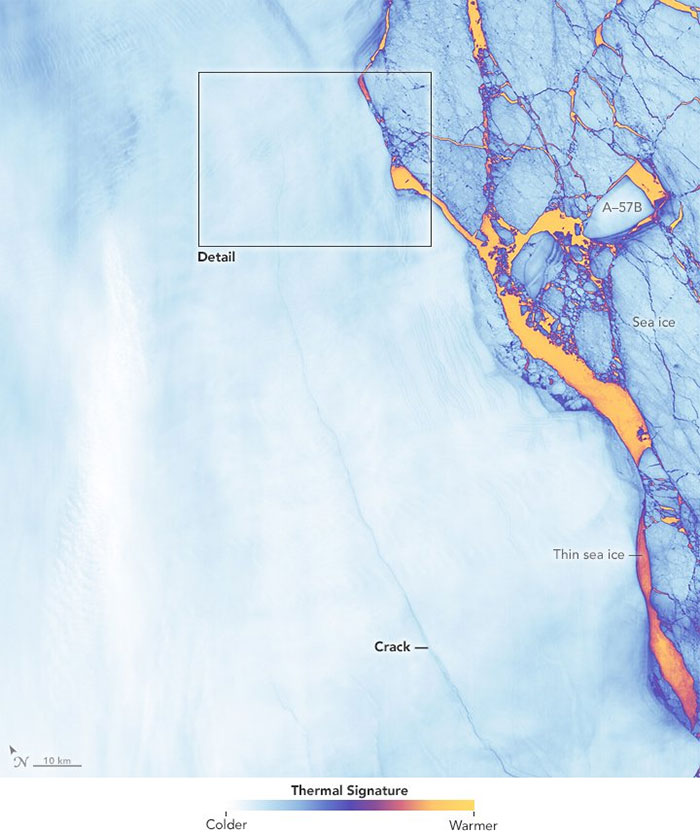Despite a recent trend of disbelief toward global warming, Mother Nature has just made herself clear. A giant, trillion-tonne iceberg has just broken away from Antarctic ice shelf, and it’s an alarm we should all be heeding.
The iceberg, which has an area of roughly 4 times the size of London at 5800 km2, was part of an ice sheet known as Larsen C. Researchers at Swansea University had been watching the glacial divide for months, and using satellite imaging, they were able to determine that the iceberg ‘calved’ (broke away) from Antarctica sometime between July 10th and 12th. Hold on to your Titanic jokes for just a few more minutes, because this is actually the sign of a problem even larger than the berg itself.
Due to the rapid rising of temperatures in West Antarctica, ice shelves are becoming more fragile than ever. Not only does this massive iceberg pose a security risk to maritime traffic, its separation could cause glaciers stabilized by Larsen C to drift into the Atlantic Ocean and melt, which could raise the global water mark by 10 centimeters. The decimation of polar regions also threatens their native species, such as emperor penguins.
See it for yourself below, and read this essay by Adrian Luckman, Swansea University Professor of Glaciology and Remote Sensing.
A massive iceberg has just broken away from Antarctica, and it’s making scientists worry for the future
Image credits: Cover images
It’s estimated to weigh a trillion tonnes, and has an area of 5800 sq km, the size of a small country
Image credits: Daily Mail
The iceberg detached from the West Antarctic ice shelf Larsen C, which could now become highly unstable
Image credits: John Sonntag
Researchers at Swanlea University had been watching the glacial divide for months using satellite imagery
Image credits: Nasa
Though it may be too early to tell, this fracture in the polar landscape could be the product of global warming
Image credits: British Antartic Survey
Antarctic temperatures are rising rapidly, causing ice sheets to break apart and drift into the Atlantic Ocean
Image credits: British Antartic Survey
That rogue ice disrupts maritime safety, then melts, causing water levels all around the world to rise
Image credits: British Antartic Survey
Polar animal species, like emperor penguins, are also threatened by the slow decimation of their habitats
Image credits: British Antartic Survey
This giant iceberg will now be monitored intensely, as will the resulting fragility of the glaciers it left behind
Image credits: British Antartic Survey

















 Photographer Finds Locations Of 1960s Postcards To See How They Look Today, And The Difference Is Unbelievable
Photographer Finds Locations Of 1960s Postcards To See How They Look Today, And The Difference Is Unbelievable  Hij zet 3 IKEA kastjes tegen elkaar aan en maakt dit voor zijn vrouw…Wat een gaaf resultaat!!
Hij zet 3 IKEA kastjes tegen elkaar aan en maakt dit voor zijn vrouw…Wat een gaaf resultaat!!  Scientists Discover 512-Year-Old Shark, Which Would Be The Oldest Living Vertebrate On The Planet
Scientists Discover 512-Year-Old Shark, Which Would Be The Oldest Living Vertebrate On The Planet  Hus til salg er kun 22 kvadratmeter – men vent til du ser det indvendigt
Hus til salg er kun 22 kvadratmeter – men vent til du ser det indvendigt  Superknepet – så blir snuskiga ugnsformen som ny igen!
Superknepet – så blir snuskiga ugnsformen som ny igen!  Meteorite That Recently Fell in Somalia Turns Out to Contain Two Minerals Never Before Seen on Earth
Meteorite That Recently Fell in Somalia Turns Out to Contain Two Minerals Never Before Seen on Earth  Nearly Frozen Waves Captured On Camera By Nantucket Photographer
Nearly Frozen Waves Captured On Camera By Nantucket Photographer  It’s Official: Astronomers Have Discovered another Earth
It’s Official: Astronomers Have Discovered another Earth 